SUSPENDED ANIMATION #235

My great love for the original Hanna-Barbera Jonny Quest series is no secret. However, there were thirteen episodes that most animation fans seem to forget – but I did research on them for the first (and only) issue of the magazine Korkis and Cawley’s Cartoon Quarterly published in 1988.
 Here is some of that information about a series that featured contributions from Frank Brunner, Will Meugniot, Larry Houston, Ric Estrada, Iwao Takamoto, Jim Stenstrum, Michael Swanigan, Eric Chu, Mel Keefer, Mike Vosburg, Bruce Zick, and many others.
Here is some of that information about a series that featured contributions from Frank Brunner, Will Meugniot, Larry Houston, Ric Estrada, Iwao Takamoto, Jim Stenstrum, Michael Swanigan, Eric Chu, Mel Keefer, Mike Vosburg, Bruce Zick, and many others.
Over the years, Hanna-Barbera considered many requests to revive their 1964 Jonny Quest series. With the success of the hour and a half Funtastic World of Hanna-Barbera in the syndication market, H-B decided to expand the program to two hours but needed a half hour adventure segment.
It was decided to produce thirteen new episodes of Jonny Quest to be shown with the original twenty-six and if the show proved popular, then another twenty-six new episodes would be produced to reach the magic syndication number of sixty-five episodes. That didn’t happen.
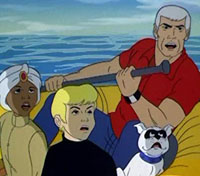 The new thirteen that premiered September 1986 featured some significant changes. Only two of the original voice artists returned to the series. Don Messick did the voices of Dr. Benton Quest and Bandit as he had done in the original series. Vic Perrin returned as the voice of the evil Dr. Zin.
The new thirteen that premiered September 1986 featured some significant changes. Only two of the original voice artists returned to the series. Don Messick did the voices of Dr. Benton Quest and Bandit as he had done in the original series. Vic Perrin returned as the voice of the evil Dr. Zin.
Jonny’s voice was now done by Scott Menville, Hadji’s voice by Rob Paulsen and Race Bannon’s voice by Granville Van Duesen. The new episodes featured additional voice work by Roger C. Carmel, Les Tremayne, Dick Gautier, Rene Auberjonois, Darryl Hickman, B.J. Ward, Keye Luke, George Takei, Frank Welker and Ed Begley Jr. among others.
The preliminary press information suggested that a new recurring character (Jessie Bradshaw, the red-headed daughter of a famous scientist, voiced by Georgi Irene) would be joining the team as a counterpart to Jonny but she only appeared in one episode. In The Real Adventures of Jonny Quest, Bannon was the father of a red-headed girl nicknamed Jessie who was Jonny’s age who appeared in all the episodes.
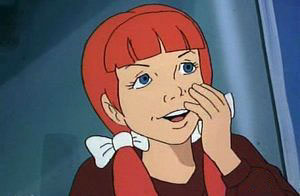
Jessie Bradshaw
The new episodes only ran twenty-two minutes instead of the original’s twenty-six which were trimmed time-wise to fit the format of the new show as well as remove some violence that was no longer acceptable.
The new episodes also featured a greater reliance on “fantasy” weapons rather than actual guns. The Quests’ giant airplane was redesigned into a flying craft called the Questor One which had a detachable reconnaissance craft named the Questor Two.
On April 8, 2014, Warner Archive as part of its Manufacture-on-Demand program released Jonny Quest- The Complete Eighties Adventures on DVD in region 1.
Here is the Filmography for those “lost” episodes:
Peril of the Reptillian: After mysterious attacks on U.S. military installations in the South Pacific, the Quests are called in to investigate. They discover Dr. Phorbus, an evil scientist who plans to use hybrid dinosaurs cloned from prehistoric remains to help him rule the world.
Nightmares of Steel: Shiek Abbu Saddi enlists the aid of Dr. Quest to help him defeat vicious raiders. They have stolen his plans for a robot horse nd use it to pillage Bedouin towns in his Middle Eastern nation.
Aliens Among Us: An alien spacecraft steals Dr. Quest’s matter transporter. When the aliens can’t make the device work, they kidnap Jonny and Hadji to force Dr. Quest to help them. When Dr. Quest and Race head to the rescue, they discover the true identity of the “aliens”.
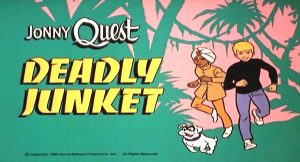 Deadly Junket: The Quest’s evil nemesis, Dr. Zin kidnaps Dr. Bradshaw. He forces him to create a missile jammer that nullifies the anti-missile system created by Dr. Quest. Jessie Bradshaw escapes her captors and enlists the aid of the Quest team to defeat Dr. Zin and save her father.
Deadly Junket: The Quest’s evil nemesis, Dr. Zin kidnaps Dr. Bradshaw. He forces him to create a missile jammer that nullifies the anti-missile system created by Dr. Quest. Jessie Bradshaw escapes her captors and enlists the aid of the Quest team to defeat Dr. Zin and save her father.
Forty Fathoms Into Yesterday: While raising a sunken German submarine, the Quest team is thrown back in time to 1944. They encounter the evil Dr. Wolfgang Kreuger who plans to use the time machine he invented to help the Germans win World War II. His plans are thwarted when the Quests sink his sub and return to the present.
Vikong Lives: In Greenland, Dr. Quest and the team find Vikong, a giant ape-like creature locked in the ice. Dr. Quest tells them he’s from a legendary race of Arctic apes the Vikings trained for battle. When Vikong comes to life, the head of the expedition threatens to put him on display in New York. It’s up to the Quests to save Vikong.
The Monolith Man: At a thermal generating plant, Zartan digs too deep in search of a form of energy that will reverse the scar on his face. He sets off an explosion. When the Quests investigate they land in a ruined underground city. They escape with a living statue, Hardrok, just as the city collaspses. Hardrok is revived and joins the Quest team.
Secret of the Clay Warriors: The Quests receive a distress call from a Chinese scientist exploring ancient tombs. They discover that nearby villages have been ravaged by ghostly clay warriors from the tombs. Further investigation reveals that the warriors are really clever thieves disguised as ghosts.
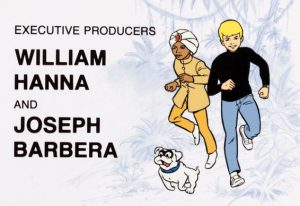 Warlord of the Sky: While investigating the appearance of unusual thunderclouds, Dr. Quest discovers that evil Maximillian Dragna has harnessed incredible electrical powers in an attempt to rule the world. Finding the secret Arctic base, Quest and company destroy Dragna’s headquarters and his powerful flying attack craft, The Dreanought.
Warlord of the Sky: While investigating the appearance of unusual thunderclouds, Dr. Quest discovers that evil Maximillian Dragna has harnessed incredible electrical powers in an attempt to rule the world. Finding the secret Arctic base, Quest and company destroy Dragna’s headquarters and his powerful flying attack craft, The Dreanought.
The Scourge of Skyborg: While testing a new computer pilot, CAP, Bannon is captured by the renegade half-robot, Skyborg. Dr. Quest and company head to the rescue and are captured. Skyborg puts Race to the test by using CAP against him. Race must employ all of his flying skills to outwit the computer and save the Quests.
Temple of Gloom: Hadji’s old mystic teacher is captured by the evil Deprave and forced to use his telepathic powers to cuase nightmares that disrupt a peace conference. Hadji is able to use his powers to help free his old master and help maintain peace throughout the region.
The Creeping Unknown: When a plant monster terrorizes the inhabitants of a swamp, the Quests investigate. They discover that the creature, in league with a botanist, has been transforming people into plants. The Quests must find a way to destroy the monster and reverse the process.
Skullduggery: An ancient crystal skull and staff leads the Quests to Dr. Zin, who plots to use the objects’ power to rule the world. Unknown to Dr. Zin, the skull and staff activate a doomsday device when he merges their power in a Druid ceremony. The Quest team must stop Zin and save the world.
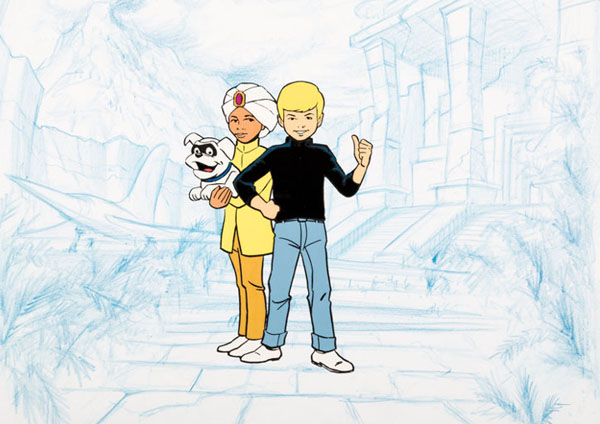


 Jim Korkis is an internationally respected animation historian who in recent years has devoted his attention to the many worlds of Disney. He was a columnist for a variety of animation magazines. With his former writing partner, John Cawley, he authored several animation related books including The Encyclopedia of Cartoon Superstars, How to Create Animation, Cartoon Confidential and Get Animated’s Animation Art Buyer’s Guide. He taught animation classes at the Disney Institute in Florida as well as instructing classes on acting and animation history for Disney Feature Animation: Florida.
Jim Korkis is an internationally respected animation historian who in recent years has devoted his attention to the many worlds of Disney. He was a columnist for a variety of animation magazines. With his former writing partner, John Cawley, he authored several animation related books including The Encyclopedia of Cartoon Superstars, How to Create Animation, Cartoon Confidential and Get Animated’s Animation Art Buyer’s Guide. He taught animation classes at the Disney Institute in Florida as well as instructing classes on acting and animation history for Disney Feature Animation: Florida.




















































Why are these episodes considered “lost” if they have been all available for the last 5 years unabridged on DVD?
This idea, perpetuated by shows like Entertainment Tonight, of something being lost simply because it has not been shown publicly on TV for a few years is nonsense.
Some of the Alice cartoons (like many silent movies) are indeed lost, because nobody currently knows of their existence.
Similarly some of the made for TV animation for The Bugs Bunny Show is also lost, as their presence appears to be unknown even by Warner Brothers.
But while the majority of the one hour episodes of The Mickey Mouse Club (1955) have not been shown on TV for many years, they are not lost – they are sitting in a Disney Vault, awaiting a future public screening (hopefully in my lifetime).
These Jonny Quest episodes could be described as rarely aired maybe, but lost?
Or am I simply lost in the definition of the word “lost”?
I am also curious as to why these 80s Jonny Quest episodes are referred to as “lost”. Would be interested to hear Jim Korkis elaborate on this.
I am sorry if my using the term “lost” was confusing or disturbing. My point was that they were “lost” because most people didn’t even know they existed and that they hadn’t been re-shown or even discussed in years so they were “lost” to any potential new viewers.
I also agree that there are some things that seem to be truly lost and hope they are found some day. That has happened by things being mislabeled in private collections or re-discovered sometimes in foreign countries. In any case, I hope you found the rest of the information interesting and that others who were unaware can “find” these “lost” episodes to satisfy their own curiosity..
Not arguing, just explaining my thought processes behind using the word “lost”.
Some ‘lost’ stuff still is around in foreign-language dubs, where the colors would have to be corrected and adjusted and the original voice tracks put back in (this YouTube video was posted last year featuring several ‘lost’ segments of “The Bugs Bunny Show” in color, but off German TV (and I think Jerry’s already said that Warners knows where all the color elements are — they just at this point apparently don’t see the profit in putting them back together for two CDs of the original show, if they’re only selling it through the Warner Archive):
https://www.youtube.com/watch?v=VmntYtLPM5k
Jonny Quest made a deep impression on me as a young boy. I used to have nightmares about Dr. Zin’s giant robot spider — but they were very cool nightmares.
However, I never saw any of the episodes from 1986 and, in fact, was unaware of their existence until now. The episode synopses are intriguing, as is the YouTube clip; but, being aware of the shortcomings of the eighties episodes of The Jetsons compared to the original, I’m inclined to be sceptical. Cutting four minutes from each of the original JQ episodes to remove violence and add extra commercials would have had a profoundly negative effect on pacing and continuity. The clip indicates that the 1986 series kept the original theme music (remixed), and I hope they had the wisdom to retain the distinctive background music of the original series as well. As I recall, the music to Hanna-Barbera cartoons in the eighties was pretty dreadful; hearing it in Jonny Quest, one might expect Bandit to grow an enormous head and start yelling “Puppy power!” Then, too, there would have been the inevitable Say No To Drugs messages that were endemic to all ’80s cartoons. No, the time for new episodes of Jonny Quest was in 1965, when ABC offered to renew the series for a second season, but Bill Hanna pulled the plug on it.
Georgi Irene! She was a child/teen actress in the eighties who did voiceover work for cartoons like “Wildfire”, “The Get Along Gang”, and “Yogi Bear’s All-Star Comedy Christmas Caper”. But I’ll always remember her for the two-part episode of “Married… with Children” in which Kelly Bundy has her own TV show, “Vital Social Issues N’ Stuff”. Georgi played one of Kelly’s friends, and she looked very fetching in a tight fuchsia mini dress. Another animation connection: Heather Grimes, who played another of Kelly’s friends in that episode, is the sister of Scott Grimes, who voices Steve on “American Dad!”
I can’t believe the villain of “The Monolith Man” is named “Zartan”. Zartan was one of the Cobra villains — the one with the Alice Cooper makeup — in the G.I. Joe cartoons of the eighties. I know Hanna-Barbera was in the habit of stealing from other cartoons, but this is ridiculous.
I’ve just finished the whole Quest series (almost done with season two of The Real Adventures) and have to say that the “eighties adventures” (as Warner Archive titles the DVD) is about as close as any HB revival gets to a revival of a 60s series, with of course some reservations.
In the real world, changing economics and social mores necessitate changes in remakes. The New Adventures of Jonny Quest couldn’t possibly have the budget to replicate the look nor most of the animation quality of the original, but the stories are solid and as close to the source as possible. The music was given a few extra dollars to allow for a re-orchestrated but shorter main title (again by Hoyt Curtin) and while the cues are different, if you listen carefully there are little nods to the original ones.
Don Messick replaced John Stephenson in the original series. My theory is that the original was very expensive and Messick was already doubling as Bandit, so Stephenson was compensated by being cast constantly in subsequent H-B series. Mike Road, who was also an H-B staple, must have been ill or have moved away by the time the new show was being recorded, but Granville Van Dusen does a remarkable job in the role.
I have a feeling the series was still more costly and time-consuming than most series for H-B and that may be why they never made more episodes.
The Funtastic World of Hanna-Barbera seemed buried in syndication, not all local stations showed it and if they did it was inconsistent, and that may be why few even realized that there were new Jonny Quest episodes at all, in contrast to The Jetsons, which received more publicity and the Real Adventures of Jonny Quest, which was a major corporate initiative with fast food toys and all. Quality isn’t always marketed unless it is directed to do so by those with the power and money to make it happen.
Nothing like a marathon viewing of a complete series to give one an insightful perspective. From what you say, it sounds as if the “eighties adventures” of JQ at least treated the source material with respect.
As for the recasting of Dr. Quest, according to Wikipedia John Stephenson was replaced because Joe Barbera thought he sounded too much like Mike Road. In any case, of all the H-B stalwarts of the sixties, Don Messick was the only one who could convincingly play an intellectual. Stephenson was at his best with irascible authority figures and, conversely, villains. Daws Butler, for all his talent, was ill-suited for dramatic roles; the characters he voiced in “Riddle of the Gold”, even though he played them straight, come across as comic relief.
It’s too bad they made no attempt at the sold blacks for “modeling” in the new shows. Admittedly, they had backed off of that look considerably by the end of the original series.
It’s a lot easier to created the thick black shadows when your cels are hand-painted. Xerox would never have been able to handle those thick blacks. It would have caused Xerox to fuse each individual cel so the black toner wouldn’t chip off.
Well, I certainly haven’t thought about these episodes in a long time. I remember they were in rotation with the original shows on Cartoon Network back in the mid-90s, before the channel made a big deal about taking Jonny Quest off the air (with a big farewell marathon ending with the solemn declaration “Jonny has left the building…”).
As a kid, I didn’t realize there were only 13 ‘modernized’ episodes. I don’t even remember that the new Jessie character only appeared once. I mainly remember the Skyborg and ‘Temple of Gloom’ episodes and the fact that in these new shows Hadji literally had magical powers. “Sim Sim Salabim!”
As far as I know, this iteration of Jonny Quest was going to have 39 episodes. Am I right?